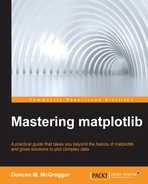The previous sections covered some heavy material, and it can be sometimes difficult to remember the big picture when examining the details under the proverbial microscope. As a preventative measure, we'd like to bring the discussion back to a macroscopic scale as it relates to knowledge acquisition.
The three layers that we've talked about in matplotlib's architecture are the backend, artist, and the scripting layers. As an intermediate user of matplotlib, you've very likely used all the three layers. However, you've most probably spent a lot of of time on the scripting layer with pyplot. This is where most users of matplotlib not only start, but usually stay. The introductory material in this book focuses on getting the users up to speed with the scripting layer so that they can be as effective as possible. Intermediate materials (such as the books for reference mentioned earlier in the chapter) also focus on this.
An in-depth usage of the artist layer is usually required when tackling complex tasks in matplotlib that require a deeper understanding of the library as a whole. These tasks might include operations such as custom transforms, scaling axes in unique ways according to the requirements of the data sets, or creating new primitives that need to be rendered by matplotlib.
As for the backend layer, it is similar to the artist layer. Custom work on the backend will arise when you either need to integrate with a new or unsupported GUI toolkit, or have specialized requirements to generate files from the plots.
With regard to the architecture of matplotlib, this book will spend some time covering certain aspects of the scripting layer, but it will spend more time on the artist and backend layers. Finally, we will move beyond matplotlib's architecture.
